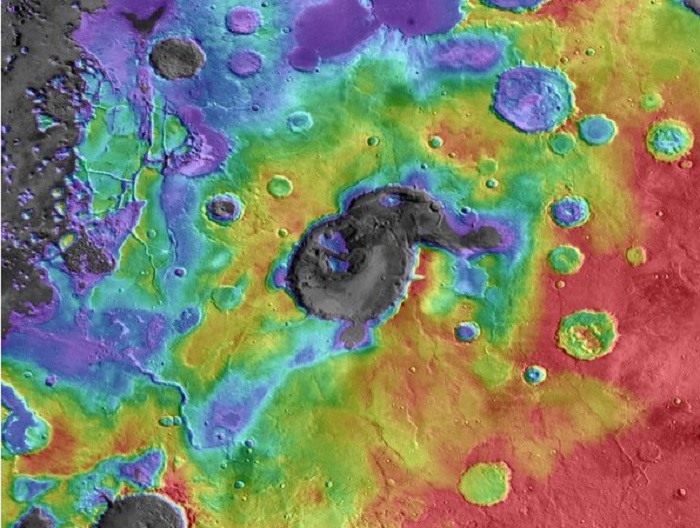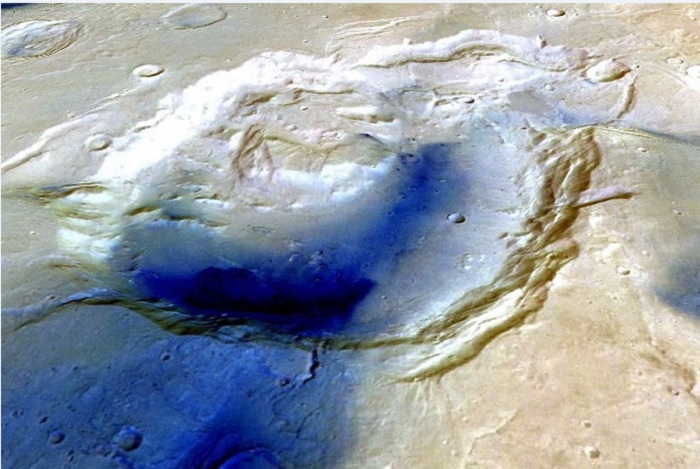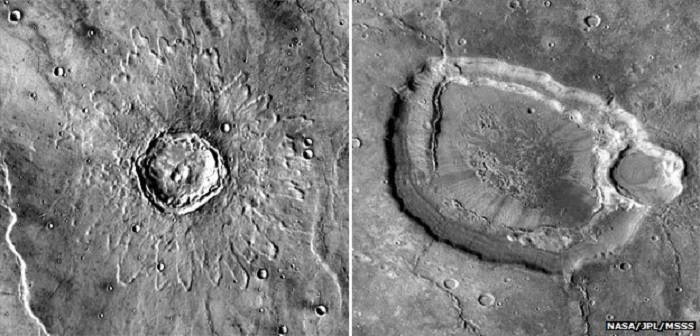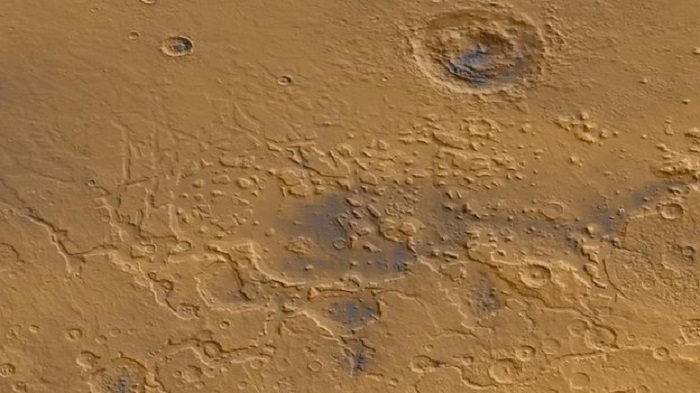.

That's no crater! First explosive supervolcanoes found on Mars
Hiding among the craters in a pockmarked Martian plain lie supervolcanoes that were so powerful that their explosions left deep scars in the ground, scientists say. The first supervolcanoes ever found on Mars, described online Wednesday in the journal Nature, could go a long way to explaining the Red Planet’s mysterious internal and atmospheric history.
While cold and dead today, Mars was once a hotbed of volcanic activity – and yet, we know very little about this aspect of its early evolution, said lead author Joseph Michalski, a planetary geologist at the Planetary Science Institute in Tucson.
“Vulcanism is a thread which is woven through every aspect of Martian geology,” Michalski said. “So this is clearly important for understanding heat flow [and] origins of the atmosphere because the atmosphere is formed through outgassing of volcanoes.”
Volcanic remains also made their way into sedimentary rocks, Michalski said. Such layered rocks make up Mt. Sharp in the middle of Gale Crater, where NASA’s rover Curiosity is headed to search for signs of life-friendly environments.
But even though volcanoes clearly played a major role in Martian history, scientists simply don’t see enough dead volcanoes to explain all of the deposits built into the planet's surface.
"In fact, 70% of the crust was resurfaced by basaltic volcanism, with a significant fraction emplaced from as yet unrecognized sources," the study authors wrote.
So where did it all come from?
Michalski said he may have chanced upon the answer. He was studying a densely cratered area in the north of Mars called Arabia Terra when he noticed a particular depression called Eden Patera that stood out from the rest.
Or rather, it stood in -- at 1.1 miles deep, it was far deeper than a crater made by an asteroid slamming into the surface. An impact crater tends to erode over time, becoming shallower.
Eden also lacked the other defining features of such craters, including a ring of ejected debris, a high ridge surrounding the basin and a mound in the middle.
Michalski teamed up with vulcanologist Jacob Bleacher of NASA’s Goddard Space Flight Center to study Eden and two other suspect craters. They concluded that these were the remains of supervolcanoes that could have exploded and put billions of tons of volcanic ash into the air, transforming the environment.
Such a volcano, like one from the quiescent supervolcano in Yellowstone National Park, would be thousands of times more powerful than the dramatic 1980 eruption of Mt. St. Helens in Washington. And this is the kind they think is made by Eden, which is roughly 43 miles wide.
These eruptions are so massive that once the magma chamber empties, the volcano collapses, leaving a crater-like depression called a caldera. This could explain why no one has found these supervolcanoes before: They don't look like shield volcanoes such as Olympus Mons, Mars' roughly 13-mile-high monster and the second tallest mountain in the solar system.
Shield volcanoes, the most common kind found on Mars, are created as lava pours out in layers over time, forming a flattened peak.
But in explosive volcanoes formed over a hot spot of magma, the gases trapped in rising magma create bubbles that explode to the surface, hurling volcanic ash into the air.
“It’s sort of like getting the bends,” Michalski said, referring to the sickness that divers can face when swimming back up to the surface too fast. “When you get the bends it’s because there’s gas dissolved in your blood and as you come up too quickly, the blood bubbles out of the gas, and that can kill you. So you've got to come up slowly. Magma does the same thing.”
The magma would have been basaltic, which usually isn’t as explosive, Michalski said. But because of Mars' lower gravity, perhaps even basaltic magmas could have gone off with a bang.
These supervolcanoes probably erupted some time within the first billion years of Mars’ life, Michalski said.
It’s possible that the explosive supervolcanoes only existed early in Mars’ history when the magma was still full of gas and could bubble up ferociously. As that gas escaped into the atmosphere, the rest of the magma would have poured out sluggishly to create shield volcanoes, like soda that has lost its fizz.
Either way, Arabia Terra might have been a good spot for supervolcanoes because the crust there is strangely thin, making it a good spot for magma to seep through, Michalski said.
Eden Patera was the clearest case of the three that the duo studied, he said, but the researchers are looking to find more calderas hiding in plain sight.
The findings provide a crucial link between what we see on Mars today and how it got there in the first place, Michalski added.
“It’s our hope that this discovery will help to open the Pandora’s box on that kind of evaluation of the early volcanic history,” he said.
Quelle: SN
.

Researchers suspect that Eden patera and other extinct supervolcanoes may have once spewed out enough ash to cover much of Mars in their rubble.
ESA/Mars Express/Freie Universitat Berlin
.

An impact crater (L) is usually circular and surrounded by an apron of ejected material. The collapsed calderas of supervolcanoes (R) look very different, with volcanic features such as terracing and pinched rims
-

Ashfall from supervolcanoes may explain the fretted - or block-like - terrains found on Mars' surface
